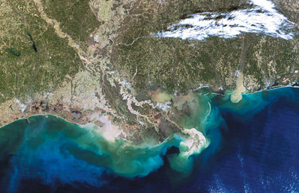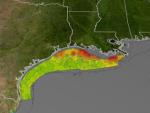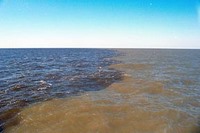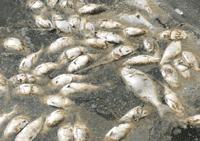News: When Green Goes Commercial: Bio-Corn Fuels Gulf of Mexico's "Dead Zone"

"Dead zones" are areas in the world's oceans where marine life can not be supported due to depleted oxygen levels. Fish can flee potential
 suffocation by migrating to other areas, but they are often quickly rendered unconscious and die. Even if they survive studies show a decrease in size of reproductive organs causing low egg counts and lack of spawning. Slow moving bottom-dwelling creatures like clams, lobsters and oysters are unable to escape. All colonial animals are extinguished. (More)
suffocation by migrating to other areas, but they are often quickly rendered unconscious and die. Even if they survive studies show a decrease in size of reproductive organs causing low egg counts and lack of spawning. Slow moving bottom-dwelling creatures like clams, lobsters and oysters are unable to escape. All colonial animals are extinguished. (More)In other words: a "dead zone" is a vicious circle turning an ocean into a desert, incapable of supporting any marine life.
 The most notorious dead zone is a 22,126 square kilometer (8,543 square mile) region in the Gulf of Mexico, the size of the State of New Jersey. The area has about doubled in size since scientists began studying it in 1985, a good enough reason to be alarmed.
The most notorious dead zone is a 22,126 square kilometer (8,543 square mile) region in the Gulf of Mexico, the size of the State of New Jersey. The area has about doubled in size since scientists began studying it in 1985, a good enough reason to be alarmed. One of the main causes of the Gulf's dead zone is the Mississippi River's dumping of high-nutrient runoff from the heart of U.S. agribusiness: the Midwest.
One of the main causes of the Gulf's dead zone is the Mississippi River's dumping of high-nutrient runoff from the heart of U.S. agribusiness: the Midwest.The principle is very simple: Agricultural fertilizer byproducts like nitrogen are running off farms into the Mississippi River, which then spills out into the Gulf of Mexico. While those chemicals help feed crops on land, the run-off builds up in the still, warm waters of the Gulf, feeding an excess growth of algae. When algae dies and decomposes, the process sucks much of the oxygen out of the water.
A sea without oxygen is little different from the surface of the moon — nothing can live there. Fish and other sea life flee, or suffocate. That creates the Gulf's dead zone.
Research in 2004 showed the Gulf's dead zone was getting smaller (More), but this hopeful cycle has now been reversed: Last year's nitrogen-fed algae bloom was the third largest in history.
The sudden expansion of the Gulf's Dead Zone is related to a recent peak in the nitrogen run-off, due to an increased use of fertilizers in the Mid West. Why was there a sudden increased use of fertilizers? After all, men has grown crops in the Mid West for decades...
Well, farmers plant increasing amounts of corn, a crop that requires heavy fertilizer, to meet the not only the growing global demand for grain but mainly to meet the demand for ethanol, a mainly corn-based biofuel. (More)
 According to a separate study published by University of British Columbia and University of Wisconsin researchers in the Proceedings of the National Journal of Sciences, corn based ethanol production is directly linked to the Gulf of Mexico dead zone. If farmers produced enough corn to meet the congressional goal of producing 15 billion gallons of ethanol by 2022, nitrogen runoff into the Gulf would increase by 10% to 19%, further expanding the Gulf's dead zone. (More)
According to a separate study published by University of British Columbia and University of Wisconsin researchers in the Proceedings of the National Journal of Sciences, corn based ethanol production is directly linked to the Gulf of Mexico dead zone. If farmers produced enough corn to meet the congressional goal of producing 15 billion gallons of ethanol by 2022, nitrogen runoff into the Gulf would increase by 10% to 19%, further expanding the Gulf's dead zone. (More)It would be a poor trade off if we killed the seas to fuel our cars.
For more information, check out this Powerpoint presentation.
More posts on The Road about biofuel, pollution, global warming and the environment.
Pictures courtesy NASA, NOAA, Uwe Kils (GFDL), peopleandplanet.net, Hans Paerl (University of North Carolina), AP.
Slide presentation courtesy Dianne Lindstedt (Gulfhypoxia.net)
 Peter. Flemish, European, aid worker, expeditioner, sailor, traveller, husband, father, friend, nutcase. Not necessarily in that order.
Peter. Flemish, European, aid worker, expeditioner, sailor, traveller, husband, father, friend, nutcase. Not necessarily in that order.
0 comments:
Post a Comment